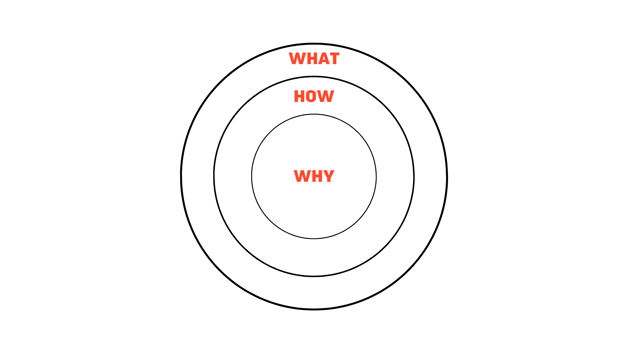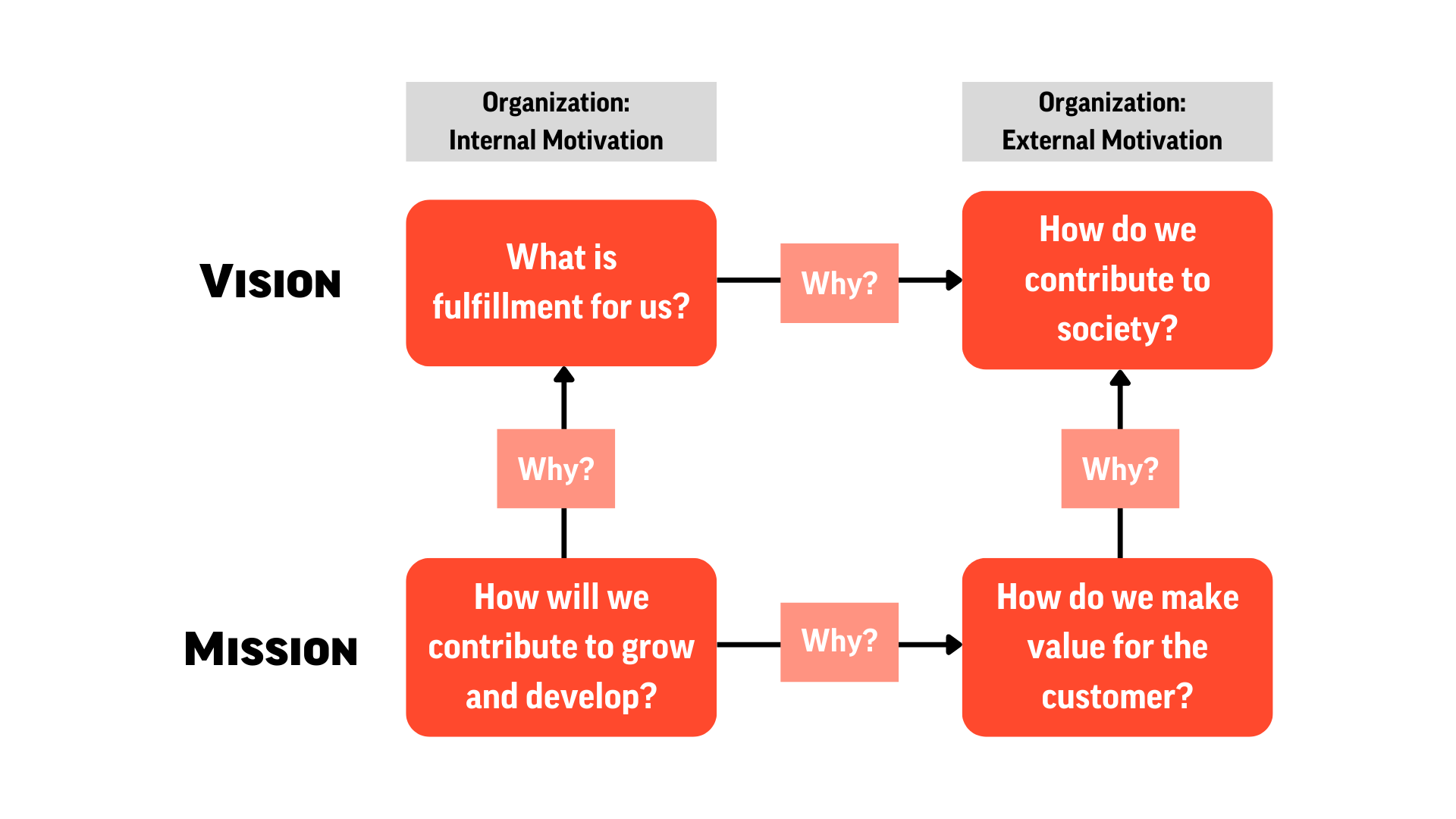Vision vs Mission Statement

Vision, mission, and value statements define a company's DNA. Yet many companies take the job of formulating them lightly. Also, there seems to be some confusion about the understanding and definition of terms, especially regarding mission and vision. In this blog, I will explain how to distinguish between vision and mission to help make corporate statements clear and easy to use for navigation, for example when formulating a strategy.
If you want to reach a goal, you must know what it is and where it is. That's true in every walk of life, and it's true in business. Direction creates results — and shared direction is the prerequisite for many to work together to create results. That's why it's crucial for a company that management and employees have a shared understanding of what it is the company wants to achieve and how it wants to do it. A basis for this common understanding is expressed by most companies in statements that explain the company's vision, mission, and values.
Unclear vision and mission statements are difficult to use
The better a company is at building consensus and a shared understanding of the core of the business and what you are aiming for, the easier it is to drive the business in the desired direction — including formulating sustainable strategies for almost every business-critical aspect. A clear direction increases enthusiasm, motivation, confidence, and satisfaction, and together with a clear value proposition, it's the backbone of that often undefinable yet vital thing called culture. When you think about how important a part of a company's DNA these statements are, it's quite disconcerting to see how lightly some companies take the work of formulating them.
First, the values stated on companies' websites are often generic — that is, they might as well have been the competitor’s or some other random company’s values. For example, what company wouldn't claim that they are "customer-oriented" or "professional"? Secondly, there seems to be some confusion about the understanding and definition of terms, especially regarding vision vs mission. Many people have obvious problems distinguishing between the two concepts, and as a result, corporate statements become unclear and difficult or impossible to use for navigation when formulating strategies. Let us take a closer look at vision vs. mission to get it right once and for all.
You must know the "Why" to formulate vision and mission statements
For a full understanding, we need to take a few steps back to determine where the assumptions about our vision and mission come from in the first place. Many will be familiar with Simon Sinek's famous model of circles with "Why" at the center and "How" and "What” respectively at the periphery. The “Why” tells you what matters to you, what drives you, and what makes you pursue your goals in life. It's true for a person, and it's true for a company. You could say it's the foundation on which everything else is built, and once you've found it, you can formulate a vision and mission that stands on solid ground because it comes from something that's true.
 A vision is anchored in this "Why", and a vision statement aims to describe a future scenario for how the world would look like if the company’s “Why” were to come to life, how the world would look like 10, 20, 50 years from now if everything went perfectly well. This vision is what the company sees for itself and is working towards, and the vision statement expresses a state that can become a reality if everything the company strives for really succeeds. It may well be something that lies far in the future, and it may even be perceived by some as unrealistic albeit worth striving for. But a wild and idealistic vision contains so much energy that you almost can't avoid creating good results if you work towards it. As the advertising guru Leo Burnett put it: "When you reach for the stars you may not quite get one, but you won't come up with a handful of mud either."
A vision is anchored in this "Why", and a vision statement aims to describe a future scenario for how the world would look like if the company’s “Why” were to come to life, how the world would look like 10, 20, 50 years from now if everything went perfectly well. This vision is what the company sees for itself and is working towards, and the vision statement expresses a state that can become a reality if everything the company strives for really succeeds. It may well be something that lies far in the future, and it may even be perceived by some as unrealistic albeit worth striving for. But a wild and idealistic vision contains so much energy that you almost can't avoid creating good results if you work towards it. As the advertising guru Leo Burnett put it: "When you reach for the stars you may not quite get one, but you won't come up with a handful of mud either."
Using "The 4 Why's" model
One way of approaching vision and mission is reflected in the model of "The 4 Why's" where there is both an internal and external perspective in relation to motivation. Using the model, the vision and mission can be identified by asking and answering basic questions about what drives the organization seen from different perspectives. The model is good because it prevents a one-sided focus on either internal or external motivators and ensures that the vision and mission statements are formulated as comprehensively as possible. Below you can see a graphic of the model:
Vision vs Mission Statements and how to distinguish between them
A mission statement aims to describe what the company actually does to achieve its vision. Ideally, it should create a clear general understanding of what the company is for and what it must do to achieve its goals. In other words: the mission statement expresses what the company is set up for. Once this is clarified, everyone will know the framework within which the company's objectives are to be achieved. The statement also usually expresses what the company wants to compete in and what it thinks it can do better than the competition. The company's mission is thus related to its value proposition, but where the mission is about the company's own understanding of its core business, the value proposition is about the customers' and the outside world's perception of what the company does for them.
Here are some clues to help distinguish: vision is a desirable scenario; mission is the basis of existence (raison d'être). Vision is the effect; mission is the cause. Vision is the future; mission is now. Vision is direction; mission is purpose. Vision inspires; mission informs. Together with the company's values, the vision and mission statements form a solid foundation that can be used at any time to guide major decisions and develop strategies. At the same time, they are a motivating factor for employees for whom a job is not just about earning a living.
Companies with a clear mission and value proposition
LinkedIn and Tesla are examples of companies that are harnessing the power of their vision and mission statements, both when developing their strategies and when communicating with customers and other stakeholders. While you could argue that their vision statements seem to be a bit fluffy, there's no wiggle room when it comes to the mission — anyone who works at Tesla or LinkedIn knows exactly why their company exists and what they need to deliver.
Tesla’s vision statement is: “To create the most compelling car company of the 21st century by driving the world’s transition to electric vehicles.” It is a very strong vision that expresses something the company wants to achieve, and some might argue that Tesla is already close to realizing it. Perhaps that is why the company's founder has embarked on a new and even wilder vision. LinkedIn’s vision is: “To transform the way the world looks for work, development, and market professional skills.” This is also a statement pointing to the future, albeit not towards a very concrete goal, because how can you tell when something is transformed? If the visions are a bit unclear, then the case is quite different when we look at the mission statements of the same two companies.
Tesla's mission statement is: “To accelerate the world’s transition to sustainable energy.” LinkedIn’s ditto is: “To connect the world’s professionals to make them more productive and successful.” Both formulations describe the company's raison d'être and make it clear what the purpose of creating, manufacturing, and marketing the company's services and products is. This reflects exactly what these companies do every day. At the same time, the formulations are not so limiting that they prevent the two companies from thinking innovatively and entering new business areas. Tesla's mission does not say that the transition to renewable energy is only about making cars. Similarly, LinkedIn's way of connecting professionals may well be through means other than a social platform.
The power of a strong vision
Perhaps the most famous vision statement in history is John F. Kennedy's iconic Moon Speech of 1961. "I believe that this nation should commit itself to achieving the goal, before this decade is out, of landing a man on the moon and returning him safely to the earth." It leaves no doubt as to what the goal is, and it will be very easy to determine whether or not it has been achieved. The example also illustrates the power of a well-articulated vision statement and the difference it can make. There is no doubt that when it comes to creating change and getting others engaged in it, it pays to take the time to carefully shape these statements.
There are many ways to do this — but if you understand the purpose and are able to clearly distinguish between vision and mission, you've already come a long way. And speaking of strong vision statements: the UK-based organization for poverty relief Oxfam has a vision that, in its simplicity, clarity, and level of ambition, sets a very clear direction for everyone working in and together with the organization: “A just world without poverty.”
And you?
Do you have a clear vision and mission statements in your company? Then, what is the next step? Formulating a strategy based on these statements and value proposition. Our strategy specialists can support you with that in a free call.











